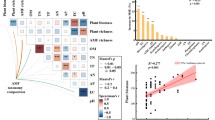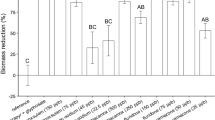Abstract
Recovery of rare aquatic plant species in eutrophic lakes often fails, and mutual allelopathic effects between cyanobacteria and submerged macrophytes are one potential reason. In this study, we investigated allelopathic interactions between cyanobacteria and Ottelia acuminata, an endangered submerged macrophyte species in China. We tested effects of Microcystis aeruginosa on germination and seedling growth of two varieties of O. acuminata (O. acuminata var. crispa, OAC; and O. acuminata var. songmingensis, OAS) and vice versa effects of culture water of young seedlings and mature macrophytes on the growth of M. aeruginosa. We found that: (1) The culture water of mature O. acuminata (both OAC and OAS) allelopathically promoted M. aeruginosa growth, while seedlings had no effect. (2) M. aeruginosa exudates and extracts significantly promoted or inhibited seed germination of O. acuminata; (3) both exudates and extracts significantly decreased the seedling vitality of OAC and OAS. (4) M. aeruginosa exudates and extracts inhibited seedlings growth of O. acuminata, especially growth of roots and the second true leaf. (5) Allelopathic effects of M. aeruginosa exudates were stronger than those of extracts, and OAC showed stronger resistance to cyanobacteria than OAS. Our results indicate that cyanobacteria can allelopathically inhibit O. acuminata mainly by their exudates, while mature O. acuminata stimulate cyanobacteria growth. Such negative effects of cyanobacteria may contribute to the disappearance of O. acuminata and also slow down their recovery in eutrophic lakes.




Similar content being viewed by others
References
Bártová K, Hilscherová K, Babica P, Marsálek B, Bláha L (2011) Effects of microcystin and complex cyanobacterial samples on the growth and oxidative stress parameters in green alga Pseudokirchneriella subcapitata and comparison with the model oxidative stressor–herbicide paraquat. Environ Toxicol 26:641–648
Blindow I, Hargeby A, Hilt S (2014) Facilitation of clear-water conditions in shallow lakes by macrophytes: differences between charophyte and angiosperm dominance. Hydrobiologia 737:99–110
Brook BW, Sodhi NS, Bradshaw CJ (2008) Synergies among extinction drivers under global change. Trends Ecol Evol 23:453–460
Chang WY (2014) Eutrophication in the Great Lakes of the Chinese Pacific Drainage Basin: changes, trends, and management. In: Ansari AA, Gill SS (eds) Eutrophication: causes, consequences and control. Springer, Netherlands, pp 89–98
Deredec A, Courchamp F (2007) Importance of the Allee effect for reintroductions. Ecoscience 14:440–451
Eigemann F, Vanormelingen P, Hilt S (2013) Differences in sensitivities of algae towards allelochemicals are strain-specific but not correlated to the co-occurrence with allelopathic macrophytes. PLoS ONE 8:e78463
Hilt S, Gross EM (2008) Can allelopathically active submerged macrophytes stabilise clear-water states in shallow eutrophic lakes? Bas Appl Ecol 9:422–432
Hilt S, Gross EM, Hupfer M, Morscheid H, Mählmann J, Melzer A, Poltz J, Sandrock S, Scharf EM, Schneider S, Van de Weyer K (2006) Restoration of submerged vegetation in shallow eutrophic lakes—guideline and state of the art in Germany. Limnologica 36:155–171
Hilt S, Adrian R, Köhler J, Monaghan MT, Sayer C (2013) Clear, crashing, turbid and back—long-term changes of macrophyte assemblages in a shallow lake. Freshwat Biol 58:2027–2036
Jeppesen E, Søndergaard M, Jensen JP, Havens K, Anneville O, Carvalho L, Coveney MF, Deneke R, Dokulil M, Foy B, Gerdeaux D, Hampton SE, Hilt S, Kangur K, Köhler J, Lammens E, Lauridsen TL, Manca M, Miracle R, Moss B, Nõges P, Persson G, Phillips G, Portielje R, Romo S, Schelske CL, Straile D, Tatrai I, Willén E, Winder M (2005) Lake responses to reduced nutrient loading—an analysis of contemporary data from 35 European and North American long term studies. Freshwat Biol 50:1747–1771
Jiang ZT, Li H, Dao ZL (2005) Ottelia acuminata var. songmingensis a new variety of the Hydrocharitaceae from Yunnan China. Guihaia 25:424–425 (in Chinese, with English abstract)
Lauridsen TL, Sandsten H, Moller PH (2003) The restoration of a shallow lake by introducing Potamogeton spp.: the impact of waterfowl grazing. Lakes Reserv Res Manage 8:177–187
Li H (1985) The flourishing and declining of Ottelia acuminata in the Lake Dianchi. J Yunnan Univ (Nat Sci Ed) S:138–142 (in Chinese, with English abstract)
Li H (1987) The lake vegetation of Hengduan Mountains. Acta Bot Yunnanica 9:257–270
Li H, Hsu TZ (1979) The geobotanical expedition on Lake Luguhu. Acta Bot Yunnanica 1:125–137
Li YM, Peng YA, Wang YC, Xu J (2003) The pollution feature of Dianchi Lake and its control countermeasure. Yunnan Geogr Environ Res 15:32–38 (in Chinese, with English abstract)
Li Y, Zhang M, Wang RN (2005) The temporal and spatial variation of the cyanobacteria which caused the water bloom in the Lake Dianchi, Kunming, China. J Yunnan Univ (Nat Sci Ed) 27:272–276 (in Chinese, with English abstract)
Long C, Jiang Z, Dao Z (2010) Genetic diversity of Ottelia acuminata (Hydrocharitaceae) from the Eastern Himalayas, revealed by ISSR markers. Botanica Orientalis: J Plant Sci 7:56–63
Lu J, Wang H, Pan M, Xia J, Xing W, Liu G (2012) Using sediment seed banks and historical vegetation change data to develop restoration criteria for a eutrophic lake in China. Ecol Eng 39:95–103
Luo MB (2002) Ecological process and toxicological effect of microcystin in the waters of Lake Dianchi. Diploma Thesis, Yunnan University, Kunming, pp 25–32 (in Chinese, with English abstract)
Ma CL, Ao XY, Li J, Zhao N, Li NY, Chen Y (2013) Determination of 15 elements in Ottelia acuminata by microwave digestion and ICP-OES. J Food Agric Environ 11:899–902
Mulderij G, van Donk E, Roelofs JGM (2003) Differential sensitivity of green algae to allelopathic substances from Chara. Hydrobiologia 491:261–271
Nováková K, Babica P, Adamovský O, Bláha L (2011) Modulation of gap-junctional intercellular communication by a series of cyanobacterial samples from nature and laboratory cultures. Toxicon 58:76–84
Rodrigo MA, Rojo C, Alonso-Guillén JL, Vera P (2013) Restoration of two small Mediterranean lagoons: the dynamics of submerged macrophytes and factors that affect the success of revegetation. Ecol Eng 54:1–15
Rojo C, Segura M, Rodrigo MA (2013a) The allelopathic capacity of submerged macrophytes shapes the microalgal assemblages from a recently restored coastal wetland. Ecol Eng 58:149–155
Rojo C, Segura M, Cortés F, Rodrigo MA (2013b) Allelopathic effects of microcystin-LR on the germination, growth and metabolism of five charophyte species and a submerged angiosperm. Aquat Toxicol 144–145:1–10
Sand-Jensen K, Riis T, Vestergaard O, Larsen SE (2000) Macrophyte decline in Danish lakes and streams over the last 100 years. J Ecol 88:1030–1040
Sayer CD, Davidson TA, Jones JI (2010) Seasonal dynamics of macrophytes and phytoplankton in shallow lakes: a eutrophication-driven pathway from plants to plankton? Freshwat Biol 55:500–513
Sivonen K, Jones G (1999) Cyanobacterial toxins. In: Chorus I, Bartram J (eds) Toxic cyanobacteria in water: A guide to their public health consequences, monitoring and management. Spon Press, London, pp 41–111
Song LR, Chen W, Peng L, Wan N, Gan NQ, Zhang XM (2007) Distribution and bioaccumulation of microcystins in water columns: a systematic investigation into the environmental fate and the risks associated with microcystins in Meiliang Bay, Lake Taihu. Water Res 41:2853–2864
Stone R (2008) From remarkable rescue to restoration of lost habitat. Science 322:184
Suikkanen S, Fistarol GO, Grane´li E (2004) Allelopathic effects of the Baltic cyanobacteria Nodularia spumigena, Aphanizomenon flo-saquae and Anabaena lemmermannii on algal monocultures. J Exp Mar Biol Ecol 308:85–101
Sun F, Pei HY, Hu WR, Song MM (2012) A multi-technique approach for the quantification of Microcystis aeruginosa FACHB-905 biomass during high algae-laden periods. Environ Technol 33:1773–1779
Švanys A, Paskauskas R, Hilt S (2014) Effects of the allelopathically-active macrophyte Myriophyllum spicatum on a natural phytoplankton community—a mesocosm study. Hydrobiologia 737:57–66
Van der Bijl L, Sand-Jensen K, Hjermind AL (1989) Photosynthesis and canopy structure of a submerged plant, Potamogeton pectinatus, in a Danish lowland stream. J Ecol 77:947–962
Vanderstukken M, Declerck SA, Decaestecker E, Muylaert K (2014) Long-term allelopathic control of phytoplankton by the submerged macrophyte Elodea nuttallii. Freshwat Biol 59:930–941
Wan N, Song LR, Wang RN, Liu JT (2008) The spatio-temporal distribution of algal biomass in Lake Dianchi and its impact facts. Acta Hydrobiol Sin 32:184–188 (in Chinese, with English abstract)
Wu C, Chang XX, Wu F, Liu JY, Zheng GL (2008a) Studies on allelopathy of aquatic macrophytes on Synahocystis sp. J Yunnan Univ (Nat Sci Ed) 30:535–540 (in Chinese, with English abstract)
Wu C, Chang XX, Dong HJ, Li DF, Liu JY (2008b) Allelopathic inhibitory effect of Myriophyllum aquaticum (Vell.) Verdc. on Microcystis aeruginosa and its physiological mechanism. Acta Ecol Sin 28:2595–2603
Xu C, Du ZY, Chen JM, Wang QF (2012) Microsatellite primers for the endangered aquatic herb, Ottelia acuminata (Hydrocharitaceae). Amer J Bot 99:262–264
Yang MW (2002) Study on rapid determination of chlorophyll content of leaves. Chin J Spectrosc Lab 19:478–481 (in Chinese, with English abstract)
Yu GY, Liu YD, Qiu CQ, Xu XQ (2000) Macrophyte succession in Dianchi lake and relations with the environment. J Lake Sci 12:73–80 (in Chinese, with English abstract)
Zhai C, Song S, Zou S, Liu C, Xue Y (2013) The mechanism of competition between two bloom-forming Microcystis species. Freshwat Biol 58:1831–1839
Zheng GL, Xu RB, Chang XX, Hilt S, Wu C (2013) Cyanobacteria can allelopathically inhibit submerged macrophytes: effects of Microcystis aeruginosa extracts and exudates on Potamogeton malaianus. Aquat Bot 109:1–7
Acknowledgments
This research was supported by the National Natural Science Foundation of China (Nos. 31260138, U1202231) and Major Science and Technology Program for Water Pollution Control and Treatment (2012ZX07102-003).
Author information
Authors and Affiliations
Corresponding author
Additional information
Handling Editor: Piet Spaak.
Runbing Xu and Feng Wu have contributed equally to this work.
Rights and permissions
About this article
Cite this article
Xu, R., Wu, F., Hilt, S. et al. Recovery limitation of endangered Ottelia acuminata by allelopathic interaction with cyanobacteria. Aquat Ecol 49, 333–342 (2015). https://doi.org/10.1007/s10452-015-9528-1
Received:
Accepted:
Published:
Issue Date:
DOI: https://doi.org/10.1007/s10452-015-9528-1




